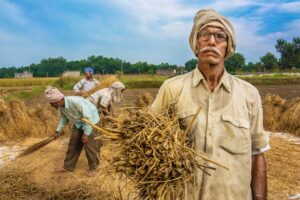Physical Address
23,24,25 & 26, 2nd Floor, Software Technology Park India, Opp: Garware Stadium,MIDC, Chikalthana, Aurangabad, Maharashtra – 431001 India
Physical Address
23,24,25 & 26, 2nd Floor, Software Technology Park India, Opp: Garware Stadium,MIDC, Chikalthana, Aurangabad, Maharashtra – 431001 India

For decades, the vast wheat fields of India have been the backbone of the nation’s food supply, but climate change is now casting a long shadow over these fields. With the country experiencing its hottest February in over a century, the heat is pushing the limits of what farmers can endure. In key wheat-producing states like Uttar Pradesh, Punjab, and Madhya Pradesh, rising temperatures threaten to reduce crop yields, jeopardizing the livelihoods of millions. As the harvest season approaches, the world’s second-largest wheat producer, India finds itself facing not just a food crisis, but an economic one too.
Major Wheat-Producing States in India
India’s wheat production is concentrated in a few key states, where favorable agro-climatic conditions, fertile soil, and developed irrigation infrastructure support high yields. Among the largest producers, Uttar Pradesh leads, contributing approximately 31.77% of India’s total wheat output. Districts like Meerut, Muzaffarnagar, and Agra are prime examples where traditional and modern farming practices combine to produce a substantial portion of the national harvest.
Madhya Pradesh is the second-largest wheat producer, accounting for 20.98% of the country’s output. The state’s Malwa plateau region, known for its black soil and moderate temperatures, provides optimal conditions for wheat cultivation. Punjab, often referred to as the “Granary of India,” ranks third, contributing 13.87% to the national production. Here, advanced farming techniques and a robust irrigation system have led to consistently high productivity levels.
These states are at the heart of India’s wheat economy, and any disruption in wheat production here can have cascading effects on the entire country’s food security and economy.
Why Are These Regions Ideal for Wheat Cultivation?
Several factors contribute to the prominence of these states in wheat production, making them highly vulnerable to the adverse effects of climate change:
Climate Change and Its Impact on Wheat Production
India’s wheat production is increasingly under threat due to the rising incidence of extreme heat during the growing and harvesting seasons. The most significant concern is the surge in temperatures during March and April, the critical months for wheat harvesting. When temperatures rise too quickly, it accelerates the wheat crop’s ripening process, reducing the grain-filling period and leading to lighter grains. This results in a decline in yield, as well as a reduction in grain quality.
For instance, in 2022, India experienced a heatwave in March, causing a sharp decline in wheat production. The projected output of 111 million tonnes fell to about 107 million tonnes. Such reductions in yield are concerning because wheat is a staple food for millions of Indians. As temperatures continue to rise, the negative effects on wheat production are expected to intensify.
The Economic and Social Consequences of Declining Wheat Production
The decline in wheat production due to extreme heat has serious implications for India’s food security, the livelihoods of farmers, and the broader economy.
India’s Wheat Fields Facing an Uncertain Future
The decline in wheat production due to climate change poses a grave threat to India’s food security and the livelihoods of millions of farmers. The impacts are felt most acutely in the country’s major wheat-producing states, where a combination of rising temperatures, reduced grain quality, and increased costs of production is already harming agricultural output. The effects of these changes ripple through the economy, affecting food prices, government procurement systems, and global trade.
As India faces these growing challenges, it is essential to develop adaptive strategies, such as improving irrigation infrastructure, investing in climate-resilient crop varieties, and enhancing weather forecasting systems. Without proactive measures, the livelihoods of millions of farmers, particularly those in vulnerable regions, will continue to be at risk. Addressing the climate crisis is not just an environmental issue—it is a pressing socio-economic concern that demands immediate and sustained attention.
References:
https://www.fao.org/india/fao-in-india/india-at-a-glance/en
11 Major Problems Faced By Indian Farmers In Agriculture In 2024
https://link.springer.com/chapter/10.1007/978-3-030-90673-3_4
Map Source: https://ipad.fas.usda.gov/countrysummary/Default.aspx?id=IN&crop=Wheat
Photo by Wandering Indian on Unsplash
https://unsplash.com/photos/a-large-field-of-hay-with-trees-in-the-background-vL_yO9OiT4E
Banner Image: Photo by Vaneet Raj on Pexels
https://www.pexels.com/photo/rural-farmers-harvesting-crops-in-indian-countryside-30320066
Comments are closed.
I aam rerally appy to gllance aat thnis blg posts which inhludes plenty off usdeful facts, tganks for providing
such data.
Our store provides a wide range of high-quality pharmaceutical products for various needs.
Our platform ensures fast and safe delivery to your location.
All products is supplied by trusted manufacturers to ensure authenticity and compliance.
You can search through our online store and get your medicines with just a few clicks.
Got any concerns? Pharmacy experts is ready to assist you 24/7.
Stay healthy with affordable e-pharmacy!
https://www.shailoo.gov.kg/kg/vybory-oktyabr-2020_/election-promises-reduce-drug-costs-and-improve-pharmaceutical-supply/